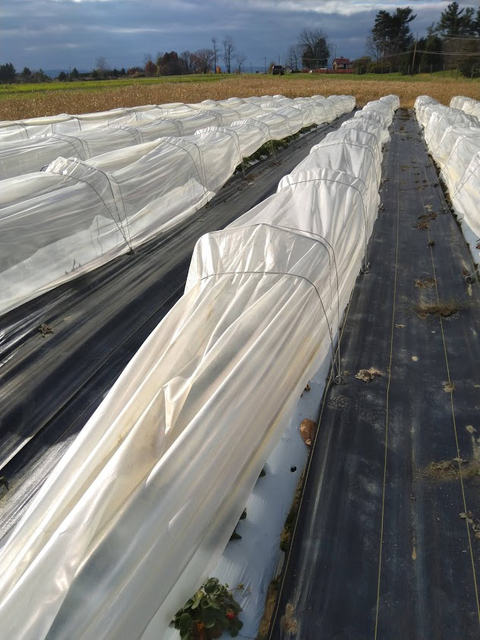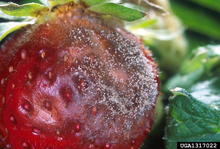Key points
- Good disease management starts with prevention.
- The early season is important for disease management when key diseases are rapidly reproducing and infecting the blossoms.
- A variety of organic and conventional fungicides are available for strawberries.
Diseases of strawberries in Minnesota
- Botrytis gray mold
- Anthracnose
- Leather rot
- Powdery mildew
- Septoria leaf spot
- Leaf blight
The top three strawberry diseases in Minnesota are botrytis, anthracnose and leather rot, as infections can get out of control quickly. Leaf diseases are common but do not frequently impact yield.
Preventing strawberry diseases
Site selection and crop management
Healthy soil is a farmer’s first line of defense against diseases. A soil with enough organic matter can contain numerous organisms such as bacteria, fungi, nematodes, protozoa, arthropods, and earthworms that may suppress soil-borne pathogens.
Well-drained soils are very important to reduce the incidence of soil-borne pathogens such as root rot diseases.
Variety selection
Many varieties have resistance to certain diseases. Refer to Strawberry varieties for Minnesota and nursery websites for more information on variety selection.
Protected culture
Planting day-neutral strawberries in low tunnels, high tunnels, or caterpillar tunnels greatly reduces disease incidence. Many diseases spread through raindrops, and these structures exclude rainfall. In particular, Botrytis fruit rot is almost nonexistent when rain does not fall on strawberry flowers.
Drip tape irrigation
Using drip tape instead of overhead sprinklers reduces disease. Overhead sprinklers should still be installed for frost protection in the spring, but it is important to be aware that overhead irrigation increases the risk of plant diseases if used for routine watering.
Despite the best efforts to prevent diseases, chances are that some disease will occur in your strawberry fields. Learn to recognize common strawberry disease symptoms, when and how they infect plants, and the weather conditions that encourage them.
Manage disease in the early season
Bloom is an important time to manage strawberry diseases. While we cannot see the disease symptoms during bloom, the fungal spores are actively spreading and infecting the plants and blossoms. The infections that occur during bloom cause symptoms we see later.
Therefore, control diseases at this point in the season to prevent damage later.
During bloom, apply effective organic or synthetic fungicides from 5-10% bloom until flowers have finished blooming, according to the application intervals on the product labels. Around the Twin Cities, bloom of June-bearing strawberries begins around the third week of May and continues through the harvest season.
Weather impacts fruit disease management
Each pathogen has a range of temperatures and rainfall requirements that promote their infection and spread. However, most of the fruit diseases thrive in warm, humid, rainy conditions. Expect to see more disease pressure during wet years and less disease during dry years.
Powdery mildew is somewhat of an exception; while infection is stimulated by wet weather, repeated subsequent rainfall tends to reduce further spread of the infection on the leaves. Therefore, seasons with wet weather followed by a prolonged dry period may experience more powdery mildew.
Warm temperatures and rain at the onset of bloom stimulate blossom infection of botrytis gray mold and anthracnose. Leaf infection by powdery mildew, leaf spot and other leaf diseases was already occurring prior to bloom but continues during bloom as temperatures become increasingly suitable for infection.
Managing common strawberry diseases
- Botrytis gray mold infections are most active between 65-75°F with rainfall.
- Apply effective fungicides at pre-bloom, early bloom, and after fruit set.
- If it has rained since your last bloom-time fungicide application, the next application should include a product with strong efficacy on botrytis.
Organic fungicide options
- Spray for botrytis during bloom and post-bloom.
- Rotate between products with efficacy against botrytis including Regalia, Optiva and Serenade (Bacillus subtilis), potassium bicarbonate, and hydrogen peroxide. These products act as preventatives or act by inducing the plant's natural defenses against pathogens and must be applied before the infection occurs.
- Refer to the Organic Production and IPM Guide for Strawberries and the manufacturer labels for more information.
Synthetic fungicide options
There are many effective synthetic fungicides effective on botrytis.
- Rotate fungicides with different modes of action to prevent resistance.
- Learn the mode of action for each product you apply, by looking at the FRAC code.
- Do not rely solely on or make repeated applications of fungicides with the same mode of action or FRAC code.
Botrytis populations with resistance to Topsin and Scala have been identified, so they should be used sparingly. Pristine and Rovral are at relatively high risk of resistance. Other products include Inspire Super, Fontelis, Captevate (Captan + fenhexamid), and Switch.
Refer to the Midwest Fruit Pest Management Guide for further guidance on rotating these products and on preventing resistance and refer to the manufacturer labels.
Several pathogens cause leaf spot symptoms on strawberry plants. These diseases include common leaf spot, angular leaf spot, Septoria leaf spot, leaf blight, and leaf scorch.
Key points about these diseases:
- They can be difficult to distinguish from one another and should be sent to the UMN Plant Disease Clinic (PDC) for a formal diagnosis. They cannot be formally diagnosed by photos alone.
- Leaf spot symptoms are extremely common on strawberries grown in Minnesota.
- Infection must be severe before it impacts fruit yield. Small infections are not a significant concern, but if infections spread and become severe they can impact yield by decreasing photosynthesis and plant vigor.
- Some diseases can also spread to the fruit and stems.
Anthracnose is an occasional disease in Minnesota but can be highly destructive. It infects the blossoms, petioles, and stems in the early season. Blossom infection leads to small, hard, misshapen fruit, and fruit rot.
Apply conventional or organic fungicides with efficacy for anthracnose during bloom if weather conditions are suitable for this disease. Ideal conditions for anthracnose development are 77-86 degrees F in conjunction with a rain event.
Fungicides for anthracnose can also be applied during the harvest season to retroactively reduce the spread of existing infections on mature fruit. By this point, economic losses have already occurred.
If the weather is warm and humid during bloom, do not delay application. Delaying control also increases the risk of infection on mature fruit.
Organic fungicide options
- Serenade products, with Serenade OPTI are reported to have the strongest efficacy. Serenade applications are most effective at the beginning of bloom or shortly before bloom, because it is preventative.
- Other options include hydrogen peroxide, Actinovate, and Double Nickel. Regalia, serifel, neem oil, and potassium bicarbonate, but their efficacy is not well documented.
- Refer to the Organic Production and IPM Guide for Strawberries and the manufacturer labels for more information.
Synthetic fungicide options
- There are a number of effective fungicides for anthracnose control, listed in the Midwest Fruit Pest Management Guide, which is updated bi-annually.
- Options include Abound, Topsin, Captan, CaptEvate, Flint Extra, Luna Sensation and Pristine.
- Rotate fungicide modes of action to prevent pathogens from developing resistance to the most effective chemistries.
When selecting fungicides, consider which other diseases the products are effective on and plan accordingly.
Observe pre-harvest intervals
According to the Midwest Fruit Pest Management Guide, "under heavy anthracnose disease pressure, all fungicides should be combined with Captan" for optimal control. However, applying Captan close to harvest should be avoided, as it leaves visible residues.
- Midwest Fruit Pest Management Guide
- Anthracnose of Strawberry - Ohio State University Extension
- Botrytis Fruit Rot/Gray Mold on Strawberries - North Carolina State University Extension
- Botrytis Gray Mold Control in Strawberries and Raspberries - Michigan State University Extension
- Strawberry Leaf Diseases | Ohioline
- Angular Leaf Spot of Strawberry – Wisconsin Horticulture
Reviewed in 2021




